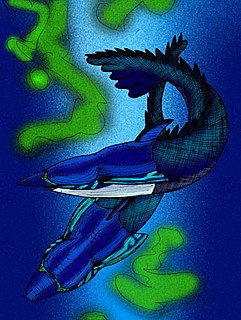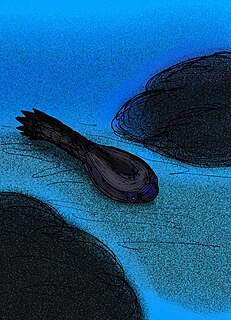The Silurian is a geologic period and system spanning 24.6 million years from the end of the Ordovician Period, at 443.8 million years ago (Mya), to the beginning of the Devonian Period, 419.2 Mya. As with other geologic periods, the rock beds that define the period's start and end are well identified, but the exact dates are uncertain by several million years. The base of the Silurian is set at a series of major Ordovician–Silurian extinction events when 60% of marine species were wiped out.

The swifts are a family, Apodidae, of highly aerial birds. They are superficially similar to swallows, but are not closely related to any passerine species. Swifts are placed in the order Apodiformes with hummingbirds. The treeswifts are closely related to the true swifts, but form a separate family, the Hemiprocnidae.

The Silurians are a fictional race of reptile-like humanoids in the long-running British science fiction television series Doctor Who. The species first appeared in Doctor Who in the 1970 serial Doctor Who and the Silurians, and were created by Malcolm Hulke. The first Silurians introduced are depicted as prehistoric and scientifically advanced sentient humanoids who predate the dawn of man; in their backstory, the Silurians went into self-induced hibernation to survive what they predicted to be a large atmospheric upheaval caused by the Earth capturing the Moon. The Silurians introduced in the 1970 story are broad, three-eyed land-dwellers. The 1972 serial The Sea Devils, also by Hulke, introduced their amphibious cousins, the so-called "Sea Devils". Both Silurians and Sea Devils made an appearance in 1984's Warriors of the Deep. After Warriors of the Deep, the Silurians did not appear in the show again before its 1989 cancellation. Heavily redesigned Silurans were reintroduced to the series in 2010, following the show's 2005 revival, and have recurred frequently since then.

The swift fox is a small light orange-tan fox around the size of a domestic cat found in the western grasslands of North America, such as Montana, Colorado, New Mexico, Kansas, Oklahoma and Texas. It also lives in Manitoba, Saskatchewan and Alberta in Canada, where it was previously extirpated. It is closely related to the kit fox and the two species are sometimes known as subspecies of Vulpes velox because hybrids of the two species occur naturally where their ranges overlap.

The Mackenzie Mountains are a mountain range forming part of the Yukon-Northwest Territories boundary between the Liard and Peel rivers. The range is named in honour of Canada's second prime minister, Alexander Mackenzie, as well as the explorer. Nahanni National Park Reserve and Nááts'ihch'oh National Park Reserve are in the Mackenzie Mountains.

Acutiramus is a genus of giant predatory eurypterid, an extinct group of aquatic arthropods. Fossils of Acutiramus have been discovered in deposits of Late Silurian to Early Devonian age. Seven species have been described, five from North America and two from the Czech Republic. The generic name derives from Latin acuto and Latin ramus ("branch"), referring to the acute angle of the final tooth of the claws relative to the rest of the claw.

Drepanopterus is an extinct genus of eurypterid and the only member of the family Drepanopteridae within the Mycteropoidea superfamily. There are currently three species assigned to the genus. The genus has historically included more species, with nine species associated with the genus Drepanopterus, however five of these have since been proven to be synonyms of pre-existing species, assigned to their own genera, or found to be based on insubstantial fossil data. The holotype of one species proved to be a lithic clast.

Erettopterus is a genus of large predatory eurypterid, an extinct group of aquatic arthropods. Fossils of Erettopterus have been discovered in deposits ranging from Early Silurian to the Early Devonian, and have been referred to several different species. Fossils have been recovered from two continents; Europe and North America. The genus name is composed by the Ancient Greek words ἐρέττω (eréttō), which means "rower", and πτερόν (pterón), which means "wing", and therefore, "rower wing".
Alainaspis platyrhina is an extinct cyathaspidid heterostracan agnathan vertebrate which existed in a marine environment in what is now the Northwest Territories of Canada, during the upper Silurian period. It was first named by David Elliott and David Dineley in 1985, and is placed in the monotypic genus Alainaspis, closely related to Boothiaspis.
Poraspis is an extinct genus of heterostracan. Fossils are found in Late Silurian and Early Devonian marine strata of Norway, Canada and the United States.
Capitaspis is an extinct genus of cyathaspidine cyathaspidid heterostracan jawless vertebrate known from the Late Silurian Somerset Island Formation of the Northwest Territories, Canada. It contains a single species, Capitaspis giblingi. It is most closely related to Pionaspis.

Panamintaspis snowi is an extinct species of pteraspidid heterostracan agnathan which existed during the early Middle Devonian period of Death Valley, California. Fossils are found in Late Emsian-aged marine strata of the Lost Burro Formation. P. snowi strongly resembles Pteraspis, though while it was originally described as a member of the same family, Pteraspididae, a recent phylogenetic reassessment of the order Pteraspidiformes places P. snowi within the paraphyletic family "Protopeteraspidae," as the sister taxon of the suborder Pteraspidoidei.

Cyathaspidida is a taxon of extinct cyathaspidiform heterostracan agnathans whose fossils are found in Silurian to Lower Devonian marine strata of Europe and North America. In life, they are thought to be benthic animals that lived most of their lives either mostly buried in or resting directly on top of the substrate.

Anglaspis is an extinct genus of cyathaspidiform heterostracan agnathan. Fossils are found in marine strata of Europe, from the late Silurian period until genus' extinction during the Early Devonian. As with other cyathaspidiforms, individuals of Anglaspis had dorsal and ventral plates covering the forebody, gill pouches, and nasal openings that lay on the roof of the oral cavity.

Cyathaspididae is an extinct family in the heterostracan order Cyathaspidiformes.

Kaibabvenator swiftae is a very large, extinct ctenacanthiform shark that lived in marine environments in what is now Arizona, during the Middle Permian Period. K. swiftae is known from large teeth up to 30 millimeters long found in the Kachina Microsite, of the lower Fossil Mountain Member, in the Kaibab Formation near Flagstaff, Arizona. The specific name honors researcher Sandra Swift for her paleontological contributions to Northern Arizona University.
Anchipteraspididae is an extinct family of heterostracan vertebrates restricted to Late Silurian and Early Devonian strata of Arctic Canada.











